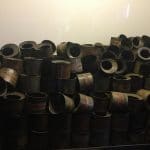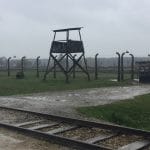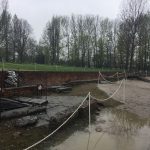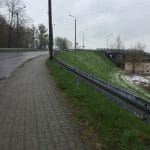Travel from Warsaw to Auschwitz-Birkenau
An Eye-opening Experience
~$80 for a day trip
While in Poland, I decided to take in one of its most famous tourist sites – which also happens to be the site of one of the 20th century’s most horrific and painful events.
In terms of budget, if you are looking for cheap and direct, there are buses from Warsaw to Auschwitz for about 20 zlote (5 USD) each way. Usually, however, people visit Krakow and take a bus or the train from Krakow to Auschwitz. To do it this way, by the train, the cost would be about 35 zlote (about 9 USD) one way (and if you are not a student, it’s about 65 zlote). Tickets to get in the Auschwitz I Memorial are 25 zlote (about 5 ot 6 USD) for students, but it is free to enter Birkenau (and Auschwitz I is free as well if you go without a guide at 4pm. I did leave a donation, however, as there is an option at the entrance to donate money into a donation box. I’d also recommend bringing about 30 USD extra (around 115-120 PLN) to buy some souvenirs/books and maybe to stop in a local diner for something to eat.
When buying a train ticket to Auschwitz, it is important that one call it by its Polish name: Oświęcim (pronounced Osh-vien-tsim). Otherwise the ticket office is not likely to understand you. A young Polish man struck up a conversation with me on the train, however, and told me that he disagreed with referring to the camps by Polish names because they were built by Germans, and should thus keep their German names. After that conversation, I spent the remainder of the train ride in silence gazing out the window, wondering who had traveled down these very railroad tracks to their suffering and death, as well as wondering how many others had taken the same train to visit Auschwitz had pondered the same thoughts I was having.
I arrived in Auschwitz at 9:30 am. I was shocked by the fact that Auschwitz I and Auschwitz II (Birkenau) camps are actually located inside of the city, not on the outskirts. It looks like a normal Polish town, until you turn a corner and see cold, brick buildings surrounded by barbed wire fences. Auschwitz II (Birkenau), in fact, sits upon one of the largest central roads in Birkenau.
Birkenau – Auschwitz II
I went to the Birkenau camp first. To get to Birkenau on foot, you walk across the railroad tracks and walk under the sign that says “Welcome to Auschwitz.” After walking under it, you will reach a main road with bus lines. You can either get on a bus or just turn right and continue walking (I walked). Once you reach an enormous grocery store called “Dobromir,” (the name of which, perhaps ironically, means “Good World”) make a left, and keep walking. You will walk across a bridge, and after continuing for a bit you will see parking for Birkenau.

You need to make a reservation online before visiting Auschwitz-Birkenau if you want a guided tour. I did try to do this, but all the spots were taken, or there were none in a language I would have needed in order to understand. However, after arriving to Birkenau’s entrance, I saw large groups of people clustered together, waiting for tour guides in various languages. It was strange to see so much vibrant life in a place known for cruel suffering and death. I went into the bookstore and bought some paper guides, so as to have some type of guide aid me around the camp, but then I found a group of English speakers and asked the guide if I could join, and she had no problem with that. I was very thankful to have found a group and a guide, as the weather would have just ruined the paper guides I had bought anyway: Winds were high and it was snowing, but due to temperatures only being about two Celsius (a little over freezing), the snow formed a cold slush as it hit the ground. Because there are no paved or brick roads/walkways at Birkenau, this created an extremely muddy situation, and my boots and the lower calf part of my jeans were completely mud-splattered. I did not mind it though, as it helped me to better connect with the testimonies of survivors from the camp who described living in such horrendous, cold, and wet conditions.
The tour guide emphasized that the purpose of Auschwitz II (Birkenau) was different than the purpose of Auschwitz I: Birkenau was an extermination camp while Auschwitz I was a work camp. The construction of Birkenau began in October 1941, so as to ease congestion at the first camp (Auschwitz I). Birkenau was built from wood taken from the Nazi demolition of local people’s homes in the town, and from resources imported from Germany. Once the “Final Solution of the Jewish Question” was ordered in January of 1942, Birkenau became a ruthless facility focused on processing death on a massive scale.
Numerous watchtowers dot the camp, and are especially prevalent near areas where “cargo” was unloaded. At these unloading points, inmates were sorted like cattle through a series of gates and holding pens. Women (elderly and mothers) and children under age 14 were all immediately sorted into the extermination line, along with elderly men and the sick, disabled, and injured. Those who were deemed healthy enough to work were sent to a different line, tattooed, disinfected, had all their hair shaved off, forced to take either a freezing cold or unbearably hot shower, and were given a pair of striped pajamas and clog shoes to begin work in the blocks while awaiting their turn for the gas chamber.
Those condemned to the extermination line of were told they were going to be given a shower, some food, and then taken to a different place where their needs could be met — but instead their hair was shaved off and they were led into gas chambers instead of showers. The remains of these gas chambers are located at the back of the Birkenau site (most of them were bombed by the Nazis before the Soviets liberated the camp). The first gas chamber — the Little Red House — was located in a converted farmhouse, and was put to use in 1942 (along with another gas chamber built the same year, known as the Little White House). By June 1943, however, both of those chambers were complemented by four other chambers, so as to increase the camp’s extermination capacity. This included installation of furnaces to begin incinerating bodies; prior to the addition of these crematoriums, gassed victims were thrown in mass graves.

After the tour of Birkenau, I spent some time wandering by myself and found an open barrack in the women’s block. In this particular barrack, foreign women and children were held, and their writings and drawings still haunt the walls. There are new carvings, however, from rude tourists. I found that barrack to be extremely haunting. There were even two paintings on the walls that the Nazis had placed there to encourage the children to work, which depict small Jewish children working in inmate uniforms.
Auschwitz I
Because I was pressed for time and needed to be on my train back to Warsaw within a few hours, I immediately headed after that to Auschwitz I. You have to buy a ticket to enter the museum and join a guided tour if it is before 4 pm. After 4 pm, you can buy a ticket and enter individually, but again, I did not have the time for that, unfortunately. They had a tour in English at 2 pm, but it was 12:30 and tours took about 2.5 hours — so instead I joined a tour in Polish at 1 pm. I surprisingly understood quite a bit of the tour. It also helps that there are signs with English descriptions for everything. So if I was unsure of something, the signs could clear up any confusion.

When entering with the tour group, we passed under the infamous metal banner that reads, “ARBEIT MACHT FREI,” which translates to English as “Work Sets You Free,” a slogan featured at a number of Nazi concentration camps. It’s taken from the title of an 1873 novel by Lorenz Diefenbach, which extols the merits of hard work and the virtues of labor. Understandably, many of the prisoners took it as an insult.
The barracks of Auschwitz I — formerly occupied by the Austrian, and later the Polish army – were requisitioned by the Nazis when the existing prisons in the Silesia region began to reach their capacity. On 21st February 1940 this complex of 16 one-story buildings were converted into a detention camp. During this time the camp was used to house Polish prisoners, with a first transport of 728 Poles arriving by train on 14th June. By March 1941, following a purge of Poland’s intelligentsia, dissidents, and resistance fighters, the Auschwitz camp held a total of 10,900 inmates.
At the Auschwitz work camp, prisoners were to work until they were unable, after which time they were exterminated. It was also a deadly human experimentation camp, where the notorious Dr. Jozef Mengele performed eugenics research on Holocaust victims (in fact, it was Mengele who sorted through the inmates taken into both Auschwitz I and Auschwitz II-Birkenau; there are many photos of him around both Birkenau and Auschwitz I steering prisoners to the right and to the left). Several rooms are dedicated to the victims of Mengele’s crimes; there are photos of women, and children, and even infants at the time of their being found, and then photos of them four months after. The pictures reveal that even after four months of healing, they were still unbearably thin, sick, and distraught, proving just how vile, inhumane, and deadly were Mengele’s experiments.
We also visited Block 20, formerly a camp hospital where prisoners were killed by lethal injections of phenol directly into the heart. A sign near the entrance explained that a few dozen prisoners were killed here in such a fashion, almost every day from 1941 onwards.
Other rooms were turned into exhibitions focused on the experiences of Hungarian Jews, Roma gypsies, French prisoners, and rooms dedicated to the women, men, and children who were experimented on and exterminated (just to name a few of the categories of victims that the museum gave special focus). In one particularly moving display, the hair of victims sent to the gas chamber are piled behind a glass screen, along with a roll of textile fabric the Nazis made out of victim’s hair. In another room, artist drawings depict the cruel, daily work life of male prisoners, and in another, images that were drawn by Jewish children murdered in the camp are shown in one vast collage. I found the images drawn by the children the most moving. The story that these images tell has much more impact than any words could ever hope to deliver.

The block that impacted me the most was the infamous Block 11, which was used for punishments. Different cells were themed for different punishments: There were “standing cells,” where the movement of prisoners was restricted and comfort completely denied; “starvation cells” in the basement, where prisoners were denied food and water until they died; and “quiet cells” as well— cells designed to deprive inmates of air and suffocate them to death, often with a candle placed in the room to speed up the process.
The basement of Block 11 was the most haunting, however. On September 1941, the SS conducted a lethal experiment using 600 Soviet prisoners-of-war and 200 Poles, sealing them inside a large chamber and gassing them with cyanide-based pesticide Zyklon-B, which was used to kill lice. The Nazis deemed the experiment a success, and a bunker on the site was subsequently converted into a gas chamber. A total of 60,000 inmates were exterminated in this bare, subterranean cell. An adjacent room was fitted with a series of ovens, and served as a crematorium. A sign posted as soon as you enter the basement asks you to remain silent, and respect the memory of the thousands of people systematically murdered in that very spot. I doubt this was really necessary, though; every person had no comment even after leaving the basement. At this point, most people had either tears in their eyes, or their eyes were completely downcast.
Visually, one might not know that the site functioned as a death factory were it placed in different scenery, such as in a field of green grass surrounded by forest; in those circumstances, these red brick buildings could almost have been attractive. It was how the site was designed to be efficient, without empathy for human life. The layout just forces one to think of production lines, of corporate livestock facilities. It is this design that evokes feelings of some of the deepest suffering known to the twentieth century. It is only these emotions that can describe the sense of clinical detachment one encounters in Auschwitz-Birkenau; words just fail.





















